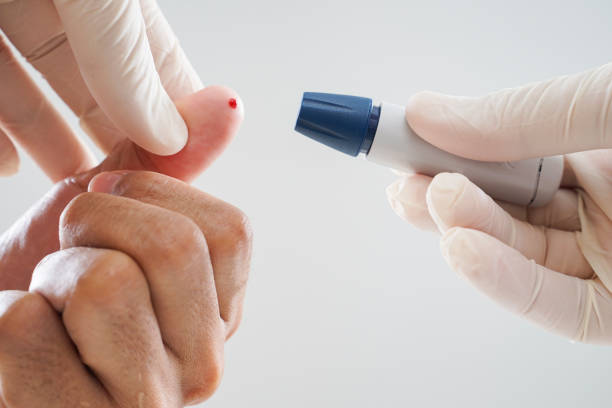What is Diabetes
“Understanding Diabetes: Causes, Symptoms, and Management”
Diabetics is a term that seems to be a misspelling of “diabetes,” which is a chronic medical condition characterized by high levels of glucose (sugar) in the blood. The primary reason for high blood glucose levels is either the body’s inability to produce enough insulin (a hormone that regulates blood sugar) or the body’s cells becoming resistant to the effects of insulin.
Types of Diabetes:
- Type 1 Diabetes: This type is an autoimmune condition where the body’s immune system attacks and destroys the insulin-producing cells in the pancreas. People with type 1 diabetes need to take insulin injections or use an insulin pump to manage their blood sugar levels.
- Type 2 Diabetes: This type is more common and is typically associated with lifestyle factors such as obesity, sedentary behavior, and poor diet. In type 2 diabetes, the body still produces insulin, but it may not be enough, or the body’s cells do not respond properly to the insulin. Type 2 diabetes can often be managed through lifestyle changes, diet, exercise, and medications.
Diabetes is a serious condition that requires ongoing management and monitoring. Uncontrolled diabetes can lead to various complications, including damage to blood vessels, nerves, and organs, and it may increase the risk of heart disease, stroke, kidney disease, and other health problems.
Gestational Diabetes:

Gestational diabetes the kind of diabetes that first manifests during pregnancy is known as gestational diabetes; elevated blood glucose levels are identified at this time. About 4% of all pregnancies are affected, and it usually goes away after the baby is born. Similar to type 1 and type 2 diabetes, the body’s cells do not efficiently utilize glucose in gestational diabetes, which results in elevated blood glucose levels. Gestational diabetes can be caused by hormonal changes during pregnancy and an increasing need for insulin as the pregnancy progresses.
The term “gestational diabetes” describes the form of diabetes that develops in pregnant women. Women who have had gestational diabetes in the past are more likely to develop type 2 diabetes in the future. Diabetes should be identified as soon as possible because it has a number of consequences and, if left untreated, can be fatal. Since diabetes typically has no outward symptoms, it is crucial to be aware of the early warning indications of the disease.
Early Warning Signs of Diabetes
Increased Thirst and Frequent Urination:
Do you think you spend the most of your day using the restroom? These might be diabetic symptoms. You lose fluid from your cells when your blood sugar level rises. Your thirst is increased as a result, and you consume more water, which causes frequent urination. High blood sugar levels result in glucose loss in urine, which draws water from your blood, fills up your bladder, and ultimately leads to frequent urination.
Increased Hunger:
People with diabetes experience hunger because their bodies are unable to utilize the blood glucose because the insulin hormone is malfunctioning. As a result, your body’s cells run out of energy, and you start to feel hungry more frequently.
Weight Gain:

Obesity increases your risk of developing diabetes. Additionally, one of the effects of diabetes is weight gain. Insulin resistance and pre-diabetes are closely linked to weight gain around the waist.
Unusual Weight Loss:
Due to the body’s inability to utilise glucose, type 1 diabetes patients are more likely to experience tissue breakdown, including the loss of muscle and fat. It results in weight loss.
Increased Fatigue:
Despite the blood having a lot of glucose. As a result of your body’s inability to utilize the blood glucose owing to a shortage of insulin, the cells go without the vital energy they require to function. As a result, you experience weariness.
Blurred Vision
Your eyes lose moisture from their lenses as a result of high blood glucose levels. Your ability to concentrate and see clearly may be harmed by this. Blindness or persistent vision difficulties may arise if diabetes is not treated or controlled.
Slow-healing Bruises or Continual Infections:
Get your blood sugar checked if wounds and bruises heal significantly more slowly than usual. Diabetes may be to blame. Elevated blood sugar (glucose) makes it harder for your body to mend itself and can make infections more likely. Infections of the bladder and vagina are becoming more common in women.
Other Symptoms:
Erectile dysfunction can occur frequently or continuously in men over 50 who are experiencing sexual dysfunction. This resulted from nerve damage brought on by excessive blood sugar. Other symptoms may appear in a diabetic with severe hyperglycemia or persistently raised glucose levels (for several hours or days).
- Dehydration
- Difficulty in Breathing
- Giddiness on standing
- Weight Loss
- Drowsiness, stupor and confusion
- Loss of consciousness or coma
Get your blood sugar levels checked if you experience symptoms that point to an increased glucose level. Even though the early signs and symptoms of diabetes may appear unimportant, a timely diagnosis improves the situation overall and lessens the likelihood of significant consequences.
While some of the risk factors for diabetes are adjustable, some are not, there are both modifiable and non-modifiable risk factors. These are some of the elements that raise the risk of diabetes:
Type 1 Diabetes
Glycated haemoglobin (A1C) test:
This test reveals the typical blood sugar level for the previous two to three months. The test is performed by calculating the percentage of blood sugar that is bound to hemoglobin, the protein in red blood cells that carries oxygen. Your blood sugar will become more hemoglobin-bound to your sugar as your blood sugar levels rise. You would be diagnosed with diabetes if your A1C level was 6.5 percent or above on two independent tests.
Random blood sugar test:
Your blood will be drawn for this test at a random time. A random blood sugar level of 200 mg/dL (11.1 mmol/L) or above will indicate that you have diabetes regardless of when you last had food. If the outcome is combined with any of the warning signs and symptoms of diabetes, such severe thirst and frequent urination, suspicion will rise.
Fasting blood sugar test:
Another type of blood sugar test involves taking a sample of your blood after fasting for the previous night. Your fasting blood sugar level is normal if it is less than 100 mg/dL (5.6 mmol/L). Prediabetes is defined as having a fasting blood sugar level of 100 to 125 mg/dL (5.6 to 6.9 mmol/L) or higher, and diabetes as having a level of 126 mg/dL (7 mmol/L) or higher on two independent tests.
Type 2 Diabetes:
Visit your primary care physician as soon as possible if you exhibit symptoms that resemble those of type 2 diabetes. He or she will suggest additional testing to make a certain diagnosis after probing your family history and the symptoms you’ve been experiencing.
Blood and Urine Tests:
The doctor looks for the presence of glucose in the blood or urine when performing a diabetes test. Diabetes patients’ kidneys may leak excess glucose into their urine. Your doctor will further request that you take a specialized blood test known as the glucose tolerance test if they see that your urine sample contains glucose. If you have diabetes or not, this test can finally determine that.
Test for Glucose Tolerance:
A glucose tolerance test, commonly known as an oral glucose tolerance test, can reveal whether or not the body has trouble processing glucose. It’s crucial to refrain from eating or drinking particular liquids for at least 8 to 12 hours prior to the test. You must inform your doctor if you take medication for any other medical condition. This is crucial since some drugs can cause the urine to become diluted. A blood sample is drawn to determine the blood’s level of glucose before the test is conducted. You will then be given a glass of a glucose-containing beverage, and two hours later, your blood will once again be measured for glucose levels.
Gestational Diabetes
Fasting Blood Glucose or Random Blood Glucose Test:

Your doctor will advise you to refrain from eating or drinking anything other than water for at least 8 hours before to the fasting blood glucose test. Your blood glucose level is checked at any moment of the day during a random blood glucose test. Both of these tests have the ability to identify gestational diabetes in certain women, but your doctor may advise additional exams to ensure diabetes is not overlooked.
Glucose Tolerance Test for 1 Hour Pregnant women are subjected to a 1-hour glucose tolerance test to check for gestational diabetes. You won’t be instructed to fast for this test, in contrast to the 3-hour glucose tolerance test. You will be given 50 gm of glucose solution to drink before the test. Within five minutes, the solution must be ingested. Due to the solution’s sweetness, some women may experience nausea after consuming it. After an hour, a blood sample is collected for glucose testing. The following diagnoses may be determined based on the findings of the one-hour glucose tolerance test:
- Normal screen: if the blood sugar level is <140 mg/dL (7.8 mmol/L)
- Abnormal result: If the blood sugar level is >140 mg/dL (7.8 mmol/L) (OGTT is recommended)
3-hour glucose tolerance test: Although it is currently most frequently used to diagnose gestational diabetes, the 3-hour glucose tolerance test is the gold standard for determining the diagnosis of type 2 diabetes. The 3-hour glucose tolerance test is advised to confirm the diagnosis of gestational diabetes if the results of the 1-hour glucose tolerance test are abnormal.
Before the 3-hour glucose tolerance test, you will be instructed to fast overnight (for at least 8 but not more than 16 hours). A sample for fasting plasma glucose level is collected the next morning. You will next be given 75 grams of the glucose solution to drink (100 grams for pregnant women). The blood glucose is then measured using blood samples. The blood glucose level is assessed five times over the course of three hours in the traditional test.
- Gestational Diabetes is diagnosed based on 3 hour glucose tolerance test if any two of the following after 100g OGTT is positive:
- Fasting plasma glucose > 95 mg/dl.
- 1-hour glucose > 180 mg/dl.
- 2-hour glucose level > 155 mg/dl.
- 3-hour glucose level > 140 mg/dl.
Tests for glucose tolerance can aid in the early detection of gestational diabetes. The difficulties linked to gestational diabetes that can affect both the mother and the fetus can be avoided with early diagnosis and effective management.
Natural Diabetes Treatment:
You will require a doctor’s support to recover from this dangerous illness; self-treatment is not an option. Along with taking prescription drugs, working out, and adhering to a balanced diet, you need to monitor your blood sugar levels. Although it is difficult to completely cure a sickness from your body, a combination of medication and certain natural remedies can assist alleviate the issue.
- Stress Reduction: Chronic stress can impact blood sugar levels, so finding ways to manage stress through relaxation techniques, meditation, yoga, or hobbies can be beneficial.
- Herbal Remedies: Some herbal supplements have been studied for their potential benefits in diabetes management. Examples include bitter melon, cinnamon, fenugreek, and aloe vera. However, it’s essential to consult with a healthcare professional before using any herbal supplements, as they may interact with medications or have adverse effects.
- Apple Cider Vinegar: Some studies suggest that apple cider vinegar may help lower post-meal blood sugar levels. However, more research is needed, and excessive consumption can have adverse effects on tooth enamel and stomach lining.
- Stay Hydrated: Drinking enough water throughout the day is essential for overall health and can help with blood sugar management.
- Adequate Sleep: Prioritize getting enough sleep each night, as poor sleep can negatively affect insulin sensitivity and blood sugar control.
- Quit Smoking: If you smoke, quitting is essential for diabetes management and overall health.
Healthy Diet:

Patients with type 1 diabetes are advised by numerous studies to follow a low-glycemic index diet in order to better control their skyrocketing blood glucose levels. A diabetic’s diet should consist primarily of low-glycemic-index foods such oats, whole wheat, fruits (apple, grape, grapefruit, pears, and coconut), and vegetables (carrots, cabbage, cauliflower, beans, and peas).
- Complex Carbohydrates: Focus on consuming complex carbohydrates that have a slower impact on blood sugar levels. These include whole grains like brown rice, quinoa, oats, whole wheat, and legumes like lentils and beans.
- Fruits and Vegetables: Include a variety of non-starchy vegetables and low-sugar fruits in your diet. Examples include leafy greens, broccoli, cauliflower, berries, apples, and citrus fruits.
- Lean Proteins: Opt for lean sources of protein like skinless poultry, fish, tofu, tempeh, beans, and low-fat dairy products. Protein can help stabilize blood sugar levels and keep you feeling full.
- Healthy Fats: Incorporate healthy fats in moderation, such as avocados, nuts, seeds, and olive oil. These fats can help improve heart health and keep you satisfied.
- Limit Sugary and Processed Foods: Minimize or avoid sugary beverages, sweets, desserts, and processed foods that are high in added sugars, unhealthy fats, and refined carbohydrates.
- Control Portion Sizes: Be mindful of portion sizes to prevent overeating, as excessive calorie intake can impact blood sugar levels and weight management.
- Frequent Meals: Instead of having large meals, spread your food intake across several small meals and snacks throughout the day to maintain steady blood sugar levels.
- Stay Hydrated: Drink plenty of water throughout the day to stay hydrated and support overall health.
- Monitor Carbohydrate Intake: Keep track of your carbohydrate intake, as it directly affects blood sugar levels. Consult a registered dietitian or diabetes educator to learn about carbohydrate counting.
- Balanced Meals: Aim for balanced meals that include a combination of carbohydrates, proteins, and healthy fats to help stabilize blood sugar levels and provide sustained energy.
Exercise:

Regular Workout can slow down the progression of diabetes. Even moderate physical exercise such as brisk walking, dancing, swimming or jogging can help you with the disease.
The treatment generally aims to keep blood sugar levels between 80 and 120 mg/dL (4.4 to 6.7 mmol/L) in the daytime and between 100 and 140 mg/dL (5.6 to 7.8 mmol/L) during the night. Therefore, you must understand that the treatment of diabetes is basically a lifelong commitment to taking insulin, exercising regularly, maintaining a healthy weight, eating healthy foods and monitoring the blood sugar level.



